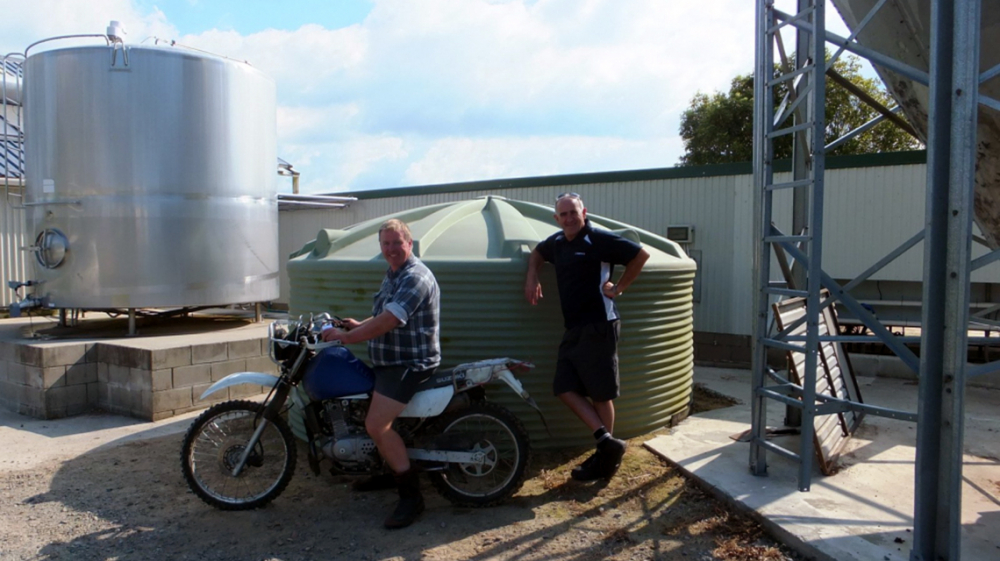Tuesday, 20 January 2015 Case Studies
Quickly Chill Milk – AND Save Money, while meeting the new regulations.
Ag Journalist Ken Strugnell visits a special cool Dairy Farm near Rotorua with Keith Turner from Temprite. Andrew Grant, the farm manager joined us with the latest power bill which showed a $350 saving on the sheds power account compared to the same month and 900 Friesian/Jersey cross cow numbers as last year. “What I really like” says Andrew “is its simplicity and automatic operation!”
I’d been told it was possible to meet Fonterra’s new milk chilling regulations and save money on power. So I was keen to find out how this special farm achieved it.
To find out more, I decided to talk to the installer of the heating and chilling equipment used on well known farmer Lachlan McKenzie’s Kaharoa dairy farm. The farm on rolling country uses a once a day milking program and as I was to find out the PROMAX insulated 30,000 litre tank works well here.
Arriving at Ngongotaha I met Temprite’s Managing Director Keith Turner. Temprite, well known in the Waikato Bay of Plenty, was the company that had installed the cooling system that I was there to look at.
I asked about Keith’s company, its relationship with PROMAX and just how the farm owner justified the claimed $350 a month on its cowshed electric bill, that was all down to the Promax Tank: Regulations are set to change for the 2016 season for the cooling of milk from the cow to the collection tanker. In the vat at collection time it now has to be chilled to 6 degrees within 2 hours of completion of milking. On this farm it was to be a retro fit to meet the new rules, one which will occur on most existing dairy farms, to abide by the regulations, as they are phased in.
I asked Keith how it worked: The ‘double bank plate cooler’, Keith explained was really the heart of the simple system. This ‘double bank cooler has milk flow through each side of the cooler unit. On the left it is chilled from the cow at around 37 degrees, by ordinary spring or tank water at around 14 – 16 degrees, as in most farm dairy sheds. That brings the milk down to around 16 – 18 degrees. The milk continues its journey round the plates this time on the right hand side, that run to and from the Promax insulated tank which has the water at 6 degrees. This brings the milk into the collection vat at around 8 degrees, sometimes less. So all the collection vat has to do is lower it by at most 2 degrees.
This not only saves money but it also is incredibly quick. Andrew Grant the farm manager joined us to show the latest power bill which had a $350 saving compared to the same month and 900 Friesian/Jersey cross cow as numbers last year.
“Quick he said the system is because the PROMAX tank water is chilled overnight on low rate power. It means that we are not spending time and energy on chilling liquid after milking, other than the cow’s milk”. Keith’s suggestion of partially burying the PROMAX tank by just over a metre, as in the photo was used to good advantage.
When I undid the tank lid and felt the temperature of the water at around midday, in full sun it was ‘shockingly cold’. The temperature gauge on the PROMAX tank read 7 degrees after milking and yet there was no condensation on the outside of the tank. “How then did they chill this water down again following milking”? I asked
“Simple really, we use the same 25kw chiller hooked up to the milk vat through which we pump the insulated tank water, using off peak overnight power. Then the 30,000 litre tank easily copes with the daily production from the 900 cows and will easily do more as you felt from how cold the water was after milking”. Keith said the tank is so efficient at keeping the milk cool that even absorbing 10 degrees off the cow’s milk does not really alter the water temperature much. Keith explained that the retro fit to meet the new regulations is an easy one to do both in terms of down time in the shed and space required.
This very ‘cool’ Dairy farm now meets the new regulations, saves money on its power bills and the fully automatic operation of the new system means little or no retraining to make it work optimally.

